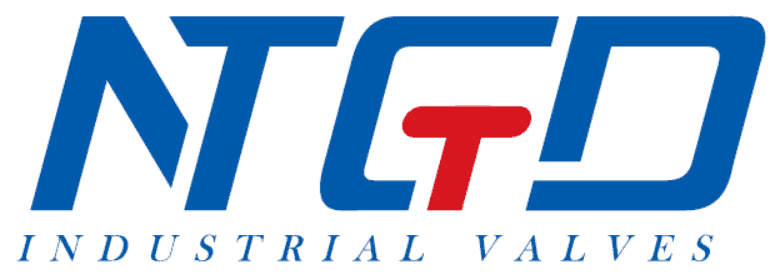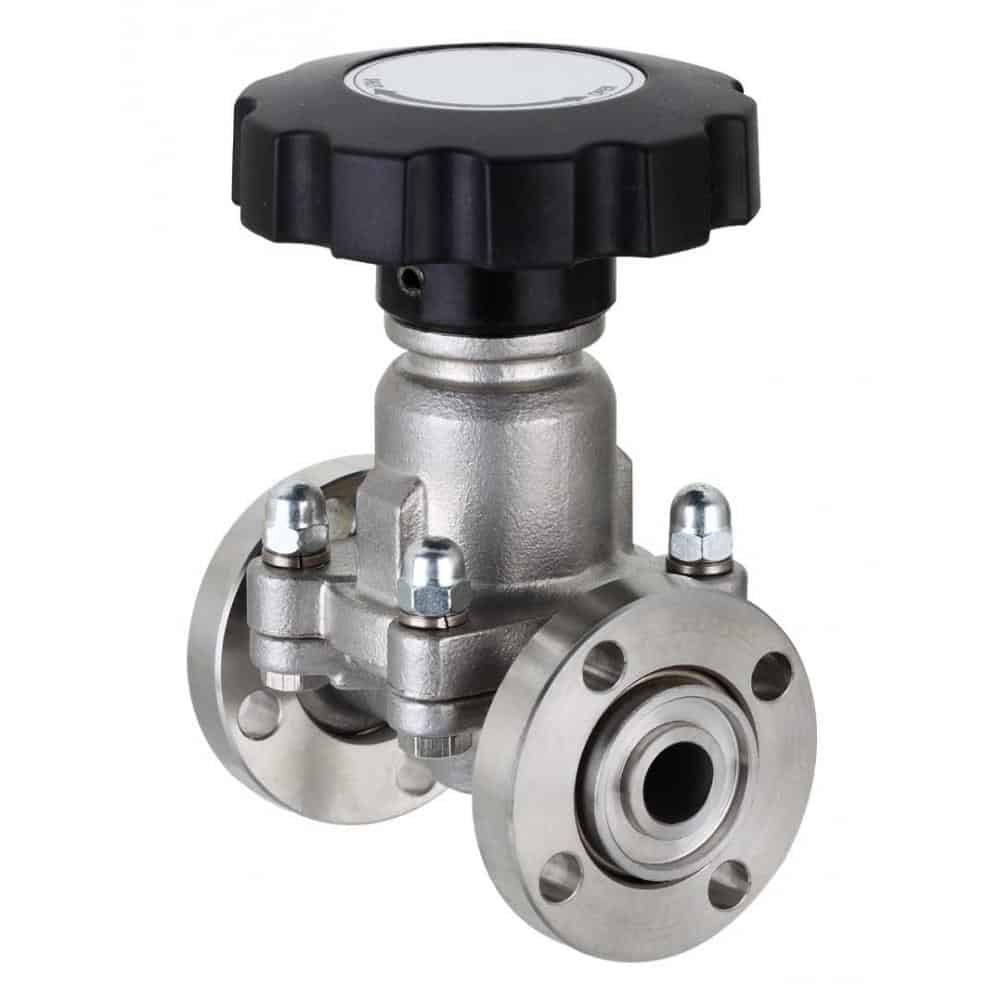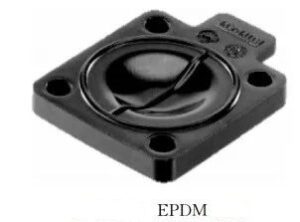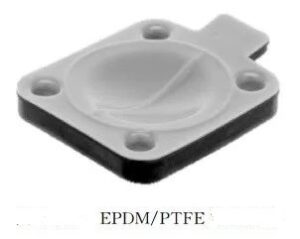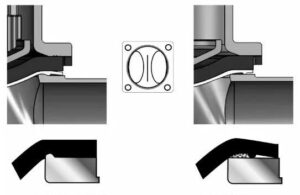1. Introduction to Diaphragms
The diaphragm is one of the most critical components of a diaphragm valve. Apart from the valve body, it is the only component that directly contacts the working medium. The diaphragm valve relies on the diaphragm to isolate the working medium, actuator, and external air. (Any component directly in contact with the product should be given special attention.)
In pharmaceutical water systems, the material of the diaphragm used in diaphragm valves must meet the relevant requirements of the FDA. The diaphragm is a moving part, and the control and shut-off of the working medium flow in the diaphragm valve are achieved by the up-and-down movement of the diaphragm. Therefore, the diaphragm is the main vulnerable spare part of the diaphragm valve.
Depending on the operating conditions, diaphragms in diaphragm valves include EPDM diaphragms (as shown in Figure below), FKM diaphragms, EPDM/PTFE composite diaphragms, and reinforced EPDM/PTFE diaphragms.
2. Diaphragm Materials
A. EPDM — Short for Ethylene-propylene-diene monomer, it is characterized by excellent elasticity, oxidation resistance, ozone resistance, and corrosion resistance. This diaphragm is suitable for polar substances, steam, hot water, cold water, alkaline media, and non-concentrated acids. EPDM has a lower temperature resistance range compared to PTFE, making it suitable for sanitary-grade processes with operating temperatures not exceeding 100°C, such as purified water systems. It’s important to note that EPDM swells when exposed to organic substances, so it is not recommended for use in conditions involving mineral oil, plant and animal fats, aliphatic or aromatic hydrocarbons, furnace solvents, or concentrated acids.
B. FKM — An abbreviation for Fluoroelastomer, it refers to a synthetic high-molecular elastic material containing fluorine atoms on the main chain or side chain carbon atoms. In addition to the high elasticity characteristic of rubber, the introduction of fluorine atoms also imparts excellent heat resistance, oxidation resistance, oil resistance, corrosion resistance, and resistance to atmospheric aging to fluoroelastomers.
C. PTFE — Poly Tetra Fluoro Ethylene, synthesized from tetrafluoroethylene, is a fluoroplastic. The chemical inertness of PTFE prevents cross-linking, so it has no “memory” to return to its original shape like an elastomer. Under tension, this material undergoes creep and deformation, known as “cold flow.” PTFE has a wide temperature range (-200~260°C) and possesses good resistance to compression, corrosion, no aging issues, resistance to water vapor and UV, and is non-toxic. However, pure PTFE diaphragms experience significant deformation at temperatures above 130°C, leading to diaphragm distortion and damage.
D. EPDM/PTFE — The EPDM/PTFE composite diaphragm, as shown in Figure below, effectively addresses the temperature resistance and toughness issues of PTFE. It combines the high elasticity of EPDM with the corrosion resistance of PTFE. Therefore, it has been widely used in high-temperature sanitary conditions such as injectable water or pure steam.
Reinforced EPDM/PTFE Diaphragm:
In addition to possessing the time-tested characteristics of ordinary EPDM/PTFE diaphragms, reinforced EPDM/PTFE diaphragms have many other advantages. Even under higher loads, the deformation of reinforced EPDM/PTFE diaphragms is much smaller. Compared to ordinary EPDM/PTFE diaphragms, they are much less affected by high temperatures and temperature changes. The compact polymer structure reduces diaphragm permeability and improves process quality. Moreover, the deformation under tension is much smaller for reinforced EPDM/PTFE diaphragms compared to ordinary EPDM/PTFE diaphragms. This advantage is even more significant under repeated loads and high-temperature conditions.
3. Diaphragm Dead Angle Prevention Design
The sealing system of the diaphragm valve directly affects the product quality of purified water and injectable water. Traditional valve sealing systems achieve sealing effects through the sealing contours on the diaphragm, and the valve body itself typically does not have additional sealing contours. Since the diaphragm is fixed to the actuator by bolts, a circular gap is formed in the sealing surface, as shown in Figure 3.136 (b) below. Medium can penetrate during each closing action and be expelled when the valve is open.
While the functional principle of the diaphragm valve has achieved the smallest dead angle, even such a small amount is enough to contaminate contact with purified water or injectable water. Figure 3.136 (a) above illustrates a newly developed dead angle-free sealing design, which has undergone comprehensive testing and verification by the EHEDG (European Hygienic Engineering and Design Group). Both the valve body and diaphragm have a sealed contour, significantly reducing the annular gap when the diaphragm is pressed against the valve body, preventing the medium from entering.
4. Requirements to Prevent Diaphragm Extractables
To ensure the purity of the medium, it is necessary not only to prevent biofilm formation and microbial contamination but also to prevent diaphragm extractables from entering the medium. Both FDA cGMP and USP specify the respective limit value extraction experiments for non-metallic substances. Only materials that comply with their relevant specifications can be granted certification.
Certificates of related material proof and certification require complete documentation. CFR21 Section 820 explicitly states that each batch or component must ensure its traceability and have relevant markings. In the event of any issues during this process, relevant documents can help people take appropriate measures to prevent events harmful to humans and the environment (e.g., recalling problematic components). For diaphragms, traceability mainly ensures that the diaphragm provides information on the manufacturer’s production date and diaphragm material.
Additionally, the production date of the diaphragm also helps in calculating the longest storage time of the diaphragm according to DIN7716. If the diaphragm is stored properly (placed in a cool, dry, well-ventilated area without heavy objects pressing on it), the service life of ethylene-propylene-diene monomer (EPDM) is 5 years, and polytetrafluoroethylene (PTFE) is 10 years. However, the longest storage time of the diaphragm does not represent its service life; the diaphragm belongs to consumable parts after undergoing switching operations and must be replaced regularly. The service life of the diaphragm depends to a large extent on the application conditions, so its maintenance cycle cannot be accurately specified in advance. In general, the maintenance cycle is based on relevant data and experience.
Please note that any specific technical or industry terminology should be reviewed by a subject matter expert in your field to ensure accuracy and suitability for your particular application.
